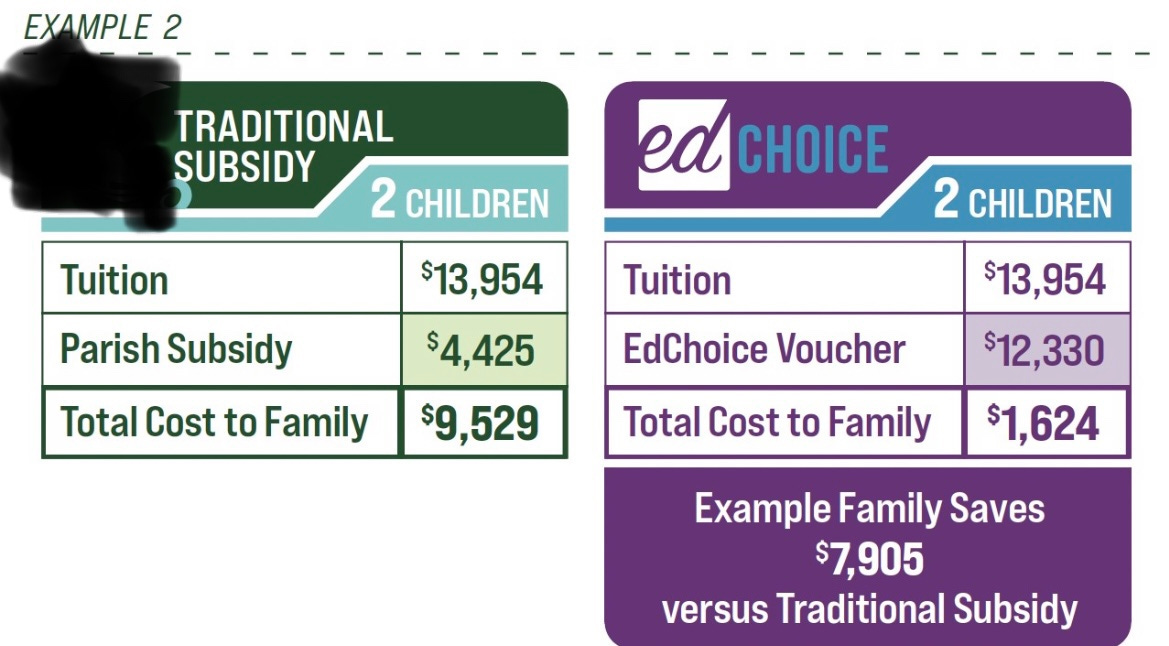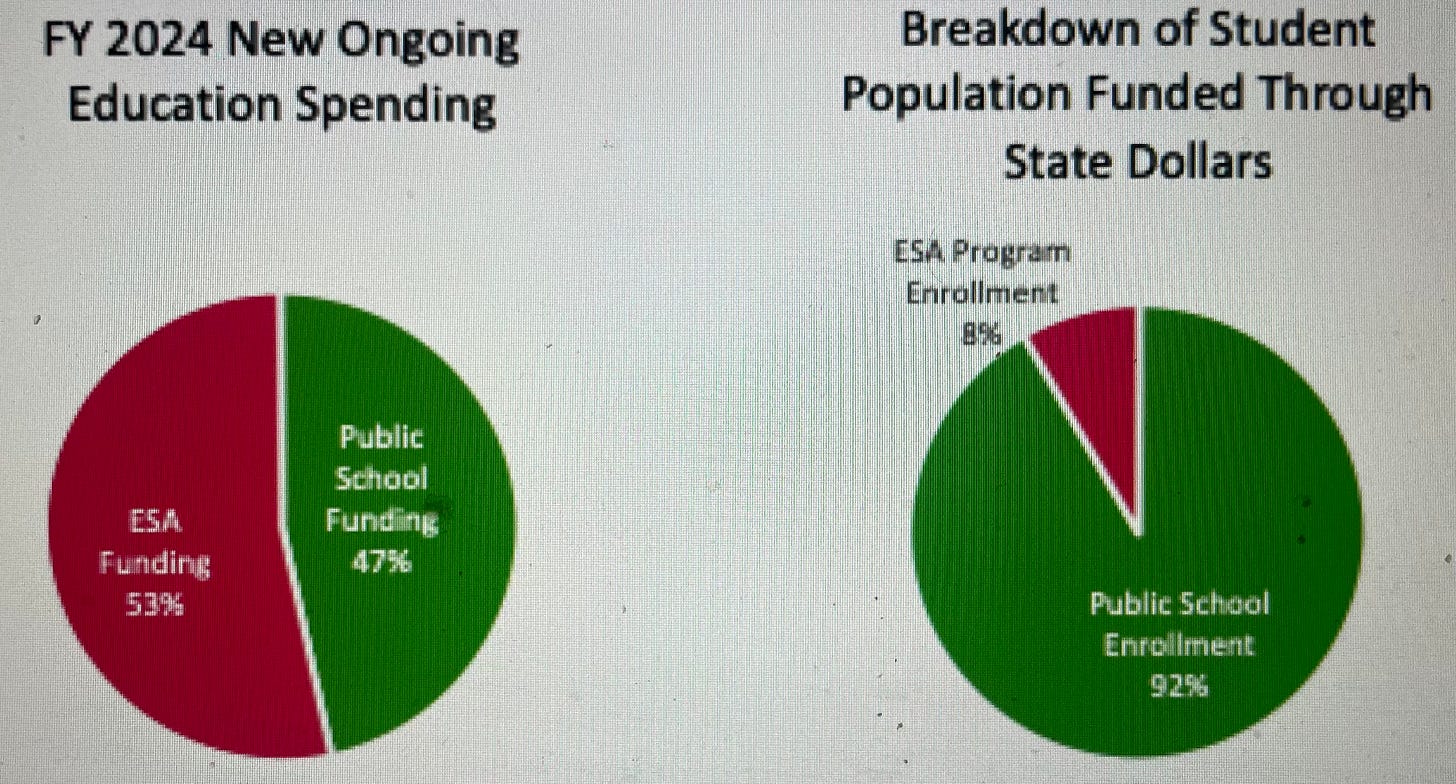A few weeks back, I shared a letter that took my breath away. And based on your replies, many of you had the same response.
It was from an Ohio parochial school administrator encouraging families who already attended the private school to take advantage of Ohio’s expanded voucher program (a “remarkable gift,” he called it). Here’s a chart he included about the savings each family would receive (as well as the elimination of the “Parish subsidy” which previously assisted families):
It’s a pretty staggering chart, isn’t it? $6,000+ per child is a heck of a “gift.”
But that one simple chart exposes something far beyond this individual school…that the elimination of prior limitations on vouchers has dramatically altered a purpose that was once targeted and sold as lifting low-income children in struggling public districts, into what is now the universal public "subsidization” of private and religious education in Ohio.
How dramatic is the shift? Try this data on for size:
Most Ohio vouchers are now paying families for students who were already attending (and could already afford) private and religious schools. In Ohio, in 2018, 3.6% of Grade 9-12 EdChoice new voucher recipients had not attended a public school in the prior year. In 2022, that number leapt to 66.6%!
Most vouchers are now subsidizing families who are not in financial need. In fact, there is no upper limit on who receives vouchers—and any family up to 450%(!) the poverty ($135,000) receives that full voucher amount. That’s 74% of Ohio families. This removal of income limits has wholly changed the overall recipient population. Ten years ago, 37% of Cleveland voucher recipients were in low-income families; that number had fallen to 7.1% by this year. Statewide recipients were 31.8% low-income in 2015; by 2023, the number had fallen to 14.9%.
When kids do change schools due to vouchers, they are, on average, enrolling in lower performing private schools. One study found: “For the few kids who did use vouchers to leave public schools, their test score drops are between -0.15 and -0.50 standard deviations. That’s almost unprecedented. As a comparison, we have to look to education policy but to natural disasters to find a similar loss. On the low end of that range is the academic loss suffered by New Orleans kids after Hurricane Katrina. On the middle end is about what COVID19 did, on average, to student growth rates. In Louisiana, Ohio—where those harmful voucher effects approach half a negative standard deviation—the loss is almost twice the pandemic’s academic impact.”
Beyond the disturbing and destructive data, the letter also begs a number of common sense questions:
1) won’t these schools simply respond to all these public “gifts” (and guaranteed revenue) by raising tuition, as this school above does?
and
2) won’t the overall costs of these vouchers explode without any of the prior limitations?
The answer is, of course, yes and yes!
So what’s my update today?
It’s that the disaster I’ve described above is happening not just in Ohio, but in states across the country.
The exact same pattern. Leading to the exact same outcomes.
What we are witnessing is a well-coordinated, national and relentless attack on public education using the same playbook in state after state. And it’s all still wrapped in the false mythical narrative that this is about helping low-income families “escape” “poor-performing public schools.”
Unfortunately, 2023 in particular is proving to be a historic year for this assault on public schools. As advocates of these dreadful policies tout: “If there ever was a watershed moment, or a watershed year…this is it.”
Let’s take a closer look around the country—where some states are actually further along than Ohio, and others are trying to catch up.
Arizona:
Arizona was one for the “first movers” in eliminating restrictions to its vouchers, and as you’d expect, costs have exploded—closing in on $1 billion—and creating a more than $300 million shortfall in the state’s budget.
Why the big cost increase? Because just like that Ohio data, a majority of those gaining voucher payments weren’t moving over from public schools, but were students already attending private schools now simply claiming the vouchers (one estimate was that this totaled as high as 75% of the voucher recipients). That makes it a pure cost increase (as opposed to a cost offset).
The explosion in voucher payments means that in Arizona, “53.25% of all new spending on education in Arizona in FY2024 is going to only 8.4% of students”!
Florida:
Florida is seeing a similar pattern—original low estimates regarding participation and cost, later exploding into billions in cost (estimated to be as high as $4 billion), and far more claiming vouchers than anticipated.
Why the higher cost? Because 70% of the voucher recipients are, again, “students already enrolled in private school.” This was three times the original estimate of students already at private schools who would claim the Florida voucher. And of course, due to letters like the one sent above pushing families to claim the savings from vouchers, these numbers are only going to go up.
Arkansas: in its newly expanded voucher program, a study found that nearly two-thirds of Arkansas students receiving a voucher were already enrolled at a private school. Income restrictions will be phased out over the next three years.
Iowa: Iowa moved to a universal system early this year, and will phase out income limitations within three years. As usual, far more applied to benefit from the program, meaning costs are already higher than anticipated.
Tennessee: the Governor this week is planning to announce the expansion of the state’s voucher program to be universal—phasing out income requirements
Other states, such as Missouri, South Carolina, Oklahoma and Indiana, also expanded vouchers and other forms of public education privatization this year, while removing limitations.
Deep Damage To Public Education
When you add it all up, along with the simultaneous ideological and rhetorical attack on our system of public education to undermine its overall popular support (CRT, “woke,” etc.), this non-stop assault is doing incalculable damage to a bedrock of our democracy which also happens to be the most important thing we can do long-term to compete and thrive as communities and as a nation:
To start, there are big-picture concerns about billions in public tax dollars supporting private and parochial schools in the first place. And it’s clear that the goal here, as the letter above states, is the permanent subsidization of private/religious education.
And long term, this massive movement of dollars threatens both overall public school funding and attendance, and the quality of education writ large, especially as so many private schools now receiving vouchers face far less regulation, oversight or transparency. There’s even a new trend of for-profit and other private schools “popping up” overnight to get their hands on this large new public revenue stream—Ohio knows how badly that turns out.
We also are seeing a near term-crisis when it comes to teacher shortages, especially in red states where both culture wars and attacks on public teaching are playing out so fiercely. States from Florida to Texas to South Carolina to Tennessee are seeing explosions in public teacher vacancies.
Why would politicians push all this, knowing full well from “early movers” like Arizona and Ohio that the results are so poor?
Well, in part, they’re being paid to inflict all this damage to the public good. Led by Betsy Devos, far-right groups contributed millions in 2022 to back state-level candidates to usher in just these policies. Think about that—politicians are being paid to knowingly destroy our systems of public education, and the children, families and communities that rely on them.
Texas: The Canary in the Coalmine
I know this all sounds pretty hopeless.
And my goal is never to leave you hopeless, so I’ve got some good news amid a difficult year on this subject.
And that good news comes out of, of all places, Texas.
Despite a very hard push by the Governor there, a bipartisan legislative coalition stopped an effort to expand vouchers in the very way other states have done elsewhere. Earlier this year, in Georgia, a similar bipartisan coalition did the same thing.
Why? How?
Well, it turns out that beyond the broader statewide damage these policies inflict, the areas that often pay the highest price for this voucher-everywhere insanity and grift are rural communities.
As in Ohio, rural areas nationwide are already struggling in too many ways. For most of rural America, as other aspects and institutions struggle, local public schools remain the center of community in countless ways (academic, social, cultural, sports, and economically). So if that school system collapses, so does the beating heart of that community.
And people know it!
And they still know it despite all the rhetorical attacks on so-called “woke” public schools. All that BS is not changing general local support and allegiance and pride for local public schools and all the good they do. (School board elections earlier this month further confirmed that.)
So, to their credit, it was rural GOP representatives in Texas and Georgia that allied with Democrats to defeat universal voucher proposals that they knew would do deep damage to their communities—and perhaps to their political futures.
And that winning alliance in those deep red states is a hint at an enormous opportunity. We must take our activism everywhere—including rural America—to forge similar coalitions in support of these centers of community.
And yes, this is also another example how gerrymandering warps democracy. Because if more politicians faced competition in elections come November, they would feel the same pressure those Texas and Georgia legislators apparently faced to do the right things by their communities.
And it’s another reminder of how we do great damage to the cause of democracy and public outcomes when we allow so many GOP incumbents to run uncontested. Because if you did run against them, going on offense about what they’re doing to local schools would be a potent issue everywhere in America—which means you’d either win the office outright, or if not, you’d create pressure for them to start doing the right thing on these issues.
But when these incumbents face no competition come Election Day (which means almost no attention to what they are doing in their statehouses), they can keep crushing their own local (and popular) schools and never face accountability for it.
2024: Let’s Commit To Battle This Issue
2023 has been a tough year for public education due to this explosion of universal vouchers and other schemes, with their negative consequences accelerating in so many states.
But Texas and Georgia show us there’s a path to stop the onslaught, and ultimately win this battle.
Let’s all commit that in 2024 (and even now, as we still have a window to recruit candidates for 2024 races), we will dramatically raise the volume and stand up to this coordinated assault on public education that is doing so much harm to our kids and communities.
I’m in!
Are you?







Share this post